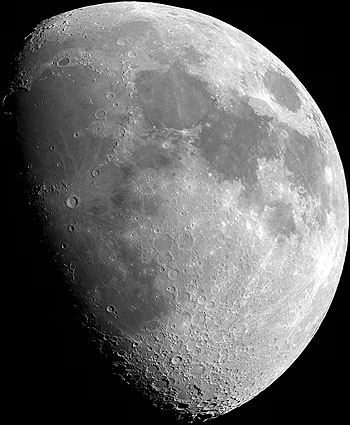August 5, 2015
A New Way to Image the Moon
Originally published August 4, 2004
Image Credit: Ivan Mhitarov |
|
A New Way to Image the Moon LPOD is about increasing scientific understanding and enjoyment of the Moon, with art and history and culture thrown in to keep us from becoming nerds. But today's LPOD is all about technique, because it is so unusual. Let Ivan explain what he has done: This image was taken at 27-th of June 2004, 3 miles east of Krasnodar, Russia by Ivan Mhitarov and Vlad Onoprienko. We used MEADE LXD-55 mount and 10" Schmidt-Newtonian F/4 telescope, 2x Barlow lens and Philips ToUcam Pro 740 inside the prime focus. The capturing technique: Navigating to the Moon limb (left), switching off the telescope's drive and starting capture AVI file while the Moon flows across the field of view. Capturing is stopped after the Moon leaving the field of view. Next step - moving and capturing the next strip. After recording 14 video "strips" I've processed all of it by K3CCDTools software and made 58 separated images with levels and unsharp mask filters. Using iMerge software, I've created this Moon mosaic. This drift-scan technique is used by asteroid searchers to cover large fields of view efficiently, but this is the first time I've heard of it being used for the Moon. Does it have advantages other than allowing drive-less scopes to take good images? I don't know. Does it introduce problems of seeing because of the prolonged exposures? Again, I don't know, but this is a pretty good image - the original is 30 mB. This also is the first LPOD from Russia and the first using a Meade LXD scope! Related Links: Yesterday's LPOD: Still on the Limb Tomorrow's LPOD: Ranger Cratering |
Author & Editor: |
COMMENTS?
Register, Log in, and join in the comments.




